Analysis of Cisco's Accounting Information System: ERP Implementation
VerifiedAdded on 2020/04/07
|9
|1691
|66
Report
AI Summary
This report provides an in-depth analysis of Cisco's Enterprise Resource Planning (ERP) implementation. It begins with an introduction highlighting the importance of Return on Investment (ROI) in technology projects and sets the general and specific objectives of the report. The report then delves into the evaluation of Cisco's ERP, detailing the challenges faced, including budgeting, relocation of IT services, and the selection of vendors. It discusses Cisco's ERP implementation process, including the impact of acquisitions, project timelines, and the challenges posed by the internet bubble burst and the post-9/11 environment. The report also examines the challenges of implementing an ERP management system, such as employee turnover, lack of trained employees, difficulties in meeting deadlines, changes in organizational culture, remodeling of processes, data standardization, and the importance of training. The recruitment of qualified personnel is also emphasized. The report concludes by summarizing the findings and highlighting the importance of planning, needs mapping, and cost-benefit analysis for a successful ERP implementation, referencing the need for process redesign and organizational change for optimal results. The report includes references to support the analysis.
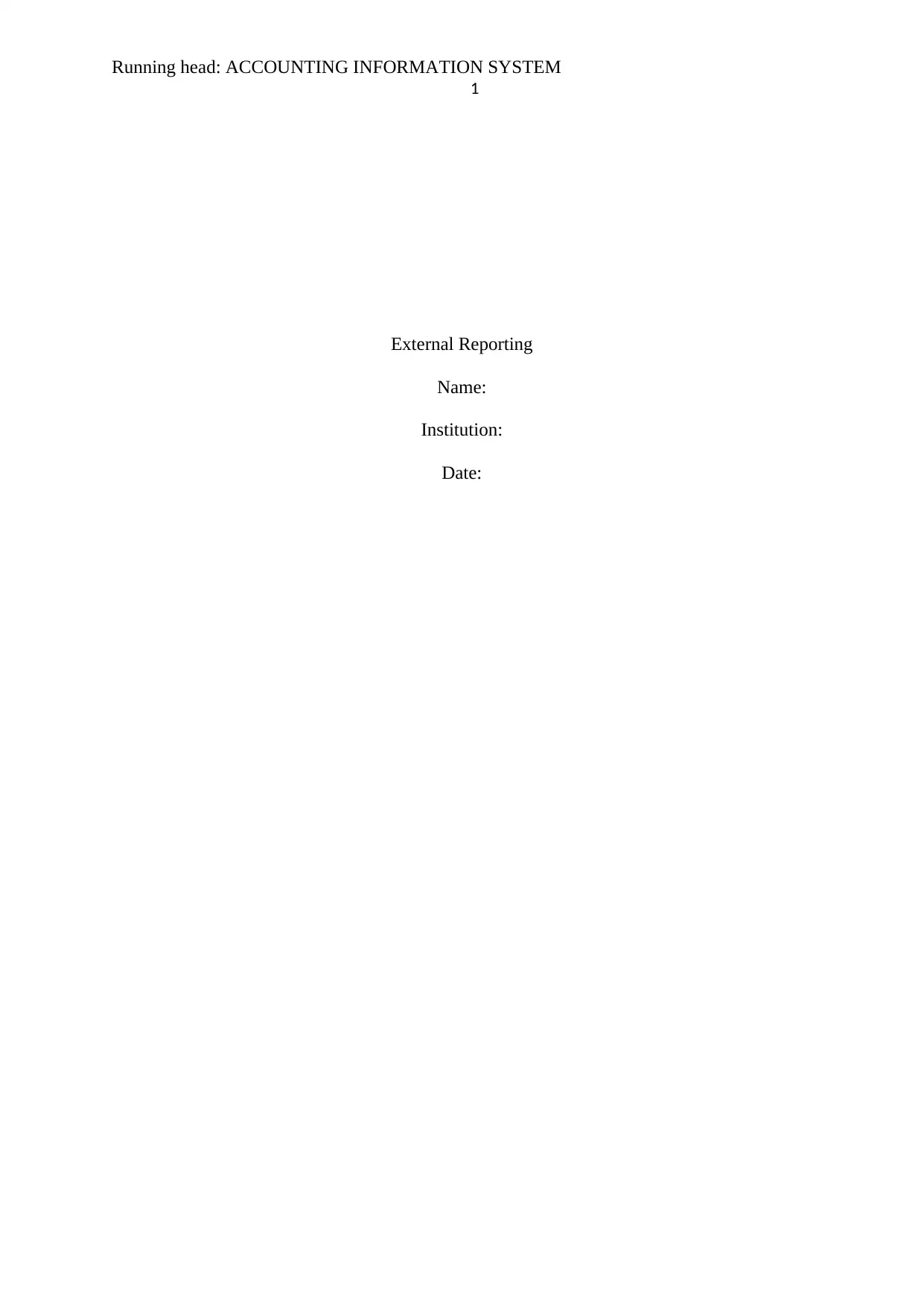
Running head: ACCOUNTING INFORMATION SYSTEM
1
External Reporting
Name:
Institution:
Date:
1
External Reporting
Name:
Institution:
Date:
Paraphrase This Document
Need a fresh take? Get an instant paraphrase of this document with our AI Paraphraser
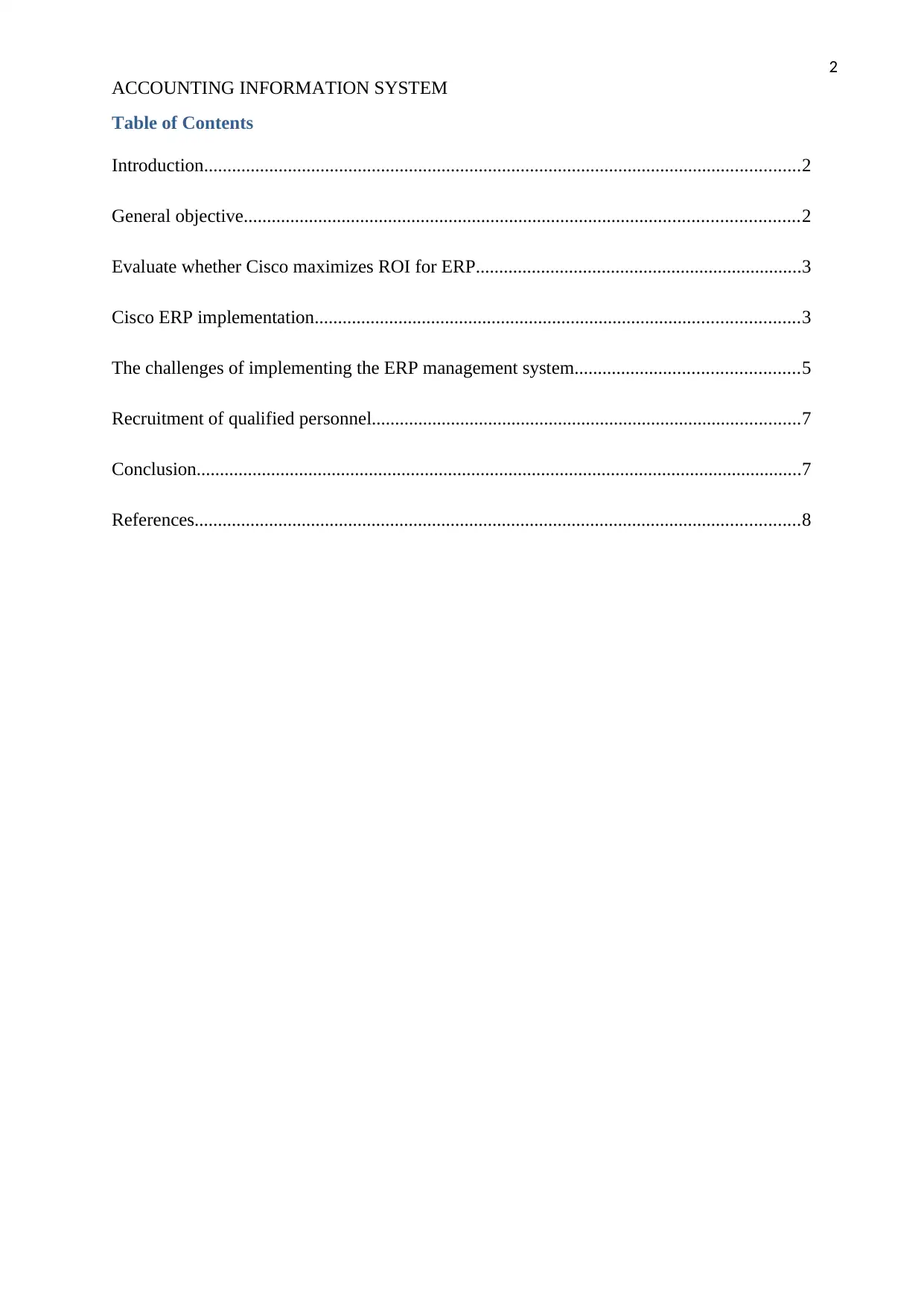
2
ACCOUNTING INFORMATION SYSTEM
Table of Contents
Introduction................................................................................................................................2
General objective.......................................................................................................................2
Evaluate whether Cisco maximizes ROI for ERP......................................................................3
Cisco ERP implementation........................................................................................................3
The challenges of implementing the ERP management system................................................5
Recruitment of qualified personnel............................................................................................7
Conclusion..................................................................................................................................7
References..................................................................................................................................8
ACCOUNTING INFORMATION SYSTEM
Table of Contents
Introduction................................................................................................................................2
General objective.......................................................................................................................2
Evaluate whether Cisco maximizes ROI for ERP......................................................................3
Cisco ERP implementation........................................................................................................3
The challenges of implementing the ERP management system................................................5
Recruitment of qualified personnel............................................................................................7
Conclusion..................................................................................................................................7
References..................................................................................................................................8
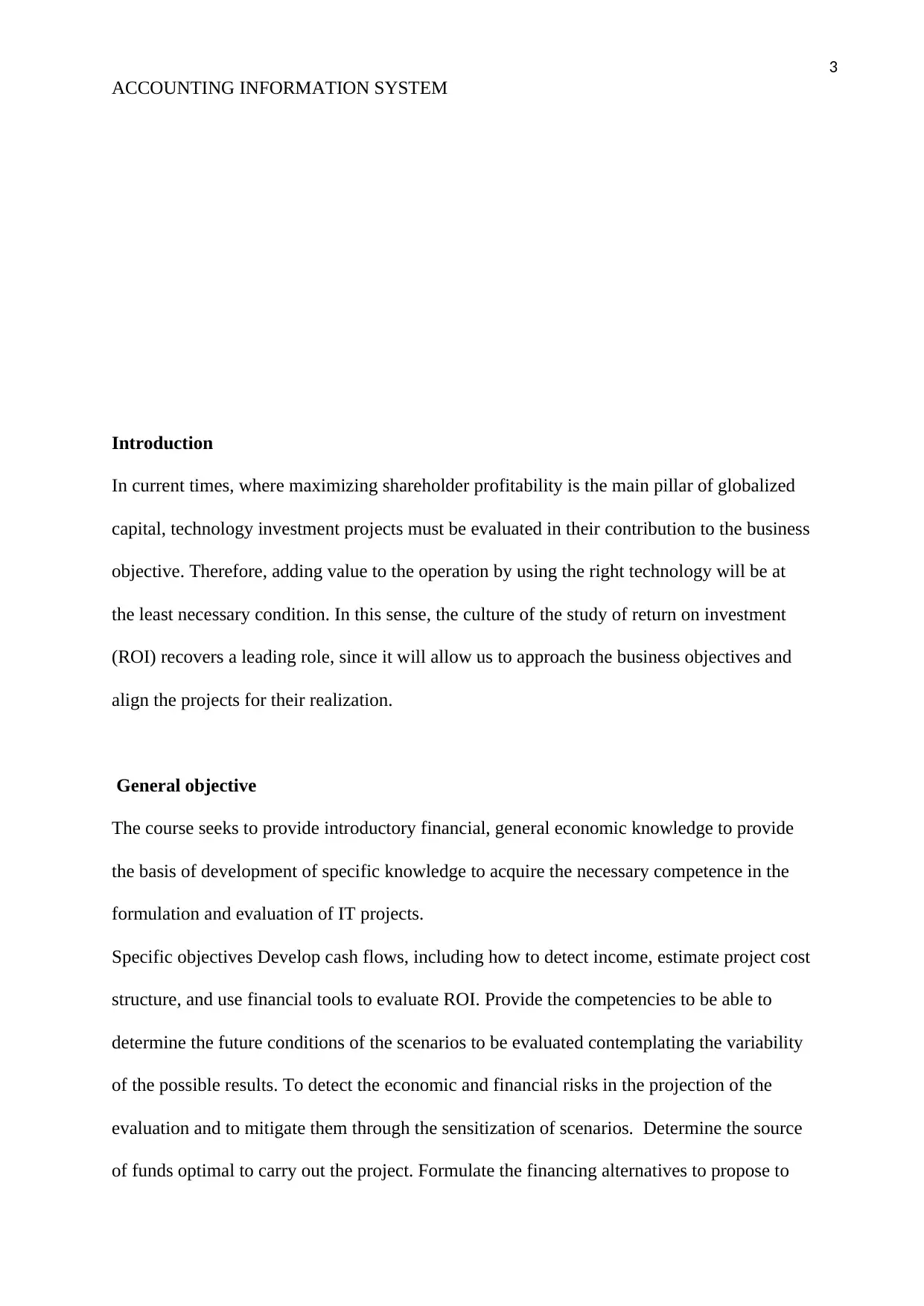
3
ACCOUNTING INFORMATION SYSTEM
Introduction
In current times, where maximizing shareholder profitability is the main pillar of globalized
capital, technology investment projects must be evaluated in their contribution to the business
objective. Therefore, adding value to the operation by using the right technology will be at
the least necessary condition. In this sense, the culture of the study of return on investment
(ROI) recovers a leading role, since it will allow us to approach the business objectives and
align the projects for their realization.
General objective
The course seeks to provide introductory financial, general economic knowledge to provide
the basis of development of specific knowledge to acquire the necessary competence in the
formulation and evaluation of IT projects.
Specific objectives Develop cash flows, including how to detect income, estimate project cost
structure, and use financial tools to evaluate ROI. Provide the competencies to be able to
determine the future conditions of the scenarios to be evaluated contemplating the variability
of the possible results. To detect the economic and financial risks in the projection of the
evaluation and to mitigate them through the sensitization of scenarios. Determine the source
of funds optimal to carry out the project. Formulate the financing alternatives to propose to
ACCOUNTING INFORMATION SYSTEM
Introduction
In current times, where maximizing shareholder profitability is the main pillar of globalized
capital, technology investment projects must be evaluated in their contribution to the business
objective. Therefore, adding value to the operation by using the right technology will be at
the least necessary condition. In this sense, the culture of the study of return on investment
(ROI) recovers a leading role, since it will allow us to approach the business objectives and
align the projects for their realization.
General objective
The course seeks to provide introductory financial, general economic knowledge to provide
the basis of development of specific knowledge to acquire the necessary competence in the
formulation and evaluation of IT projects.
Specific objectives Develop cash flows, including how to detect income, estimate project cost
structure, and use financial tools to evaluate ROI. Provide the competencies to be able to
determine the future conditions of the scenarios to be evaluated contemplating the variability
of the possible results. To detect the economic and financial risks in the projection of the
evaluation and to mitigate them through the sensitization of scenarios. Determine the source
of funds optimal to carry out the project. Formulate the financing alternatives to propose to
⊘ This is a preview!⊘
Do you want full access?
Subscribe today to unlock all pages.

Trusted by 1+ million students worldwide
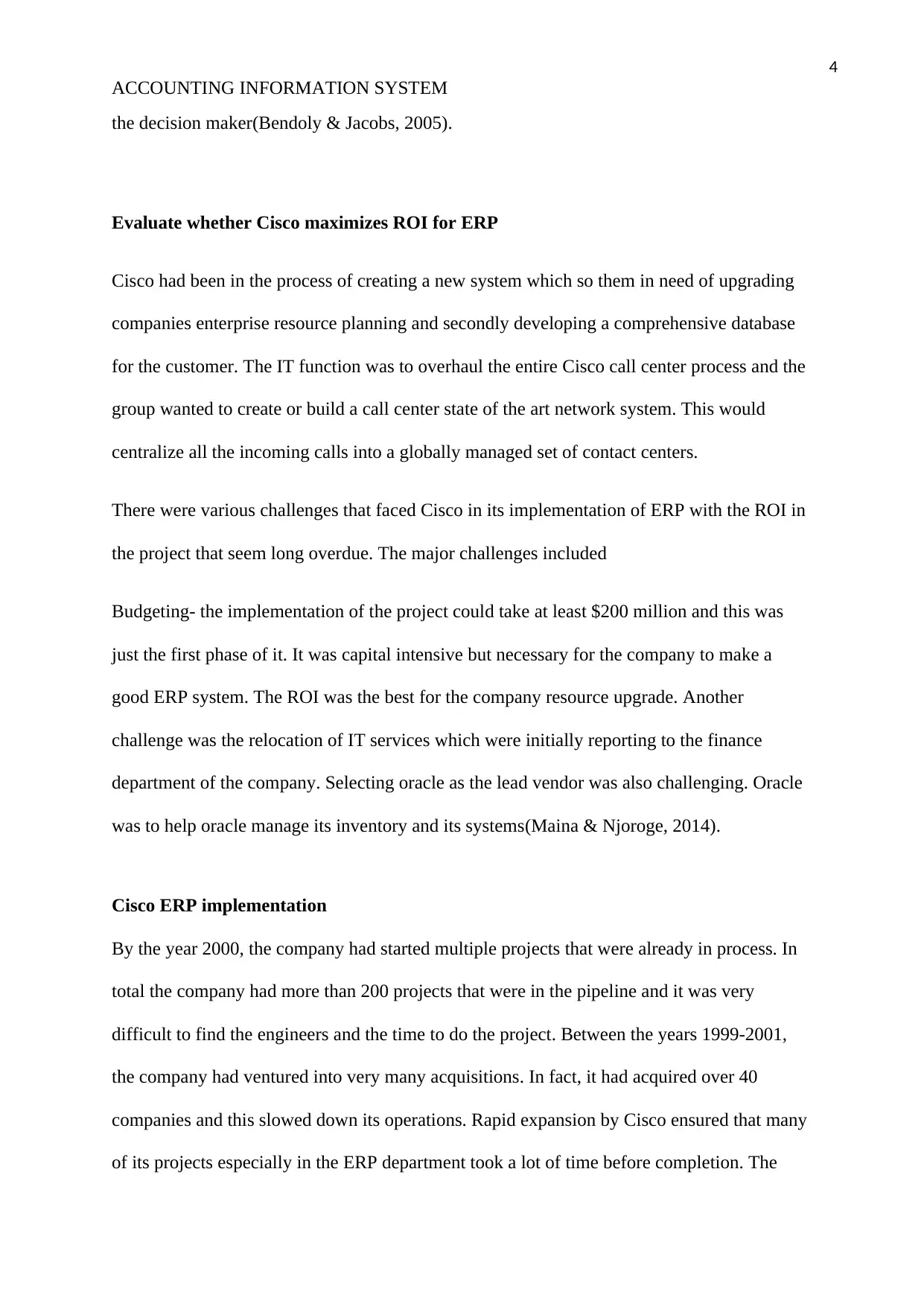
4
ACCOUNTING INFORMATION SYSTEM
the decision maker(Bendoly & Jacobs, 2005).
Evaluate whether Cisco maximizes ROI for ERP
Cisco had been in the process of creating a new system which so them in need of upgrading
companies enterprise resource planning and secondly developing a comprehensive database
for the customer. The IT function was to overhaul the entire Cisco call center process and the
group wanted to create or build a call center state of the art network system. This would
centralize all the incoming calls into a globally managed set of contact centers.
There were various challenges that faced Cisco in its implementation of ERP with the ROI in
the project that seem long overdue. The major challenges included
Budgeting- the implementation of the project could take at least $200 million and this was
just the first phase of it. It was capital intensive but necessary for the company to make a
good ERP system. The ROI was the best for the company resource upgrade. Another
challenge was the relocation of IT services which were initially reporting to the finance
department of the company. Selecting oracle as the lead vendor was also challenging. Oracle
was to help oracle manage its inventory and its systems(Maina & Njoroge, 2014).
Cisco ERP implementation
By the year 2000, the company had started multiple projects that were already in process. In
total the company had more than 200 projects that were in the pipeline and it was very
difficult to find the engineers and the time to do the project. Between the years 1999-2001,
the company had ventured into very many acquisitions. In fact, it had acquired over 40
companies and this slowed down its operations. Rapid expansion by Cisco ensured that many
of its projects especially in the ERP department took a lot of time before completion. The
ACCOUNTING INFORMATION SYSTEM
the decision maker(Bendoly & Jacobs, 2005).
Evaluate whether Cisco maximizes ROI for ERP
Cisco had been in the process of creating a new system which so them in need of upgrading
companies enterprise resource planning and secondly developing a comprehensive database
for the customer. The IT function was to overhaul the entire Cisco call center process and the
group wanted to create or build a call center state of the art network system. This would
centralize all the incoming calls into a globally managed set of contact centers.
There were various challenges that faced Cisco in its implementation of ERP with the ROI in
the project that seem long overdue. The major challenges included
Budgeting- the implementation of the project could take at least $200 million and this was
just the first phase of it. It was capital intensive but necessary for the company to make a
good ERP system. The ROI was the best for the company resource upgrade. Another
challenge was the relocation of IT services which were initially reporting to the finance
department of the company. Selecting oracle as the lead vendor was also challenging. Oracle
was to help oracle manage its inventory and its systems(Maina & Njoroge, 2014).
Cisco ERP implementation
By the year 2000, the company had started multiple projects that were already in process. In
total the company had more than 200 projects that were in the pipeline and it was very
difficult to find the engineers and the time to do the project. Between the years 1999-2001,
the company had ventured into very many acquisitions. In fact, it had acquired over 40
companies and this slowed down its operations. Rapid expansion by Cisco ensured that many
of its projects especially in the ERP department took a lot of time before completion. The
Paraphrase This Document
Need a fresh take? Get an instant paraphrase of this document with our AI Paraphraser
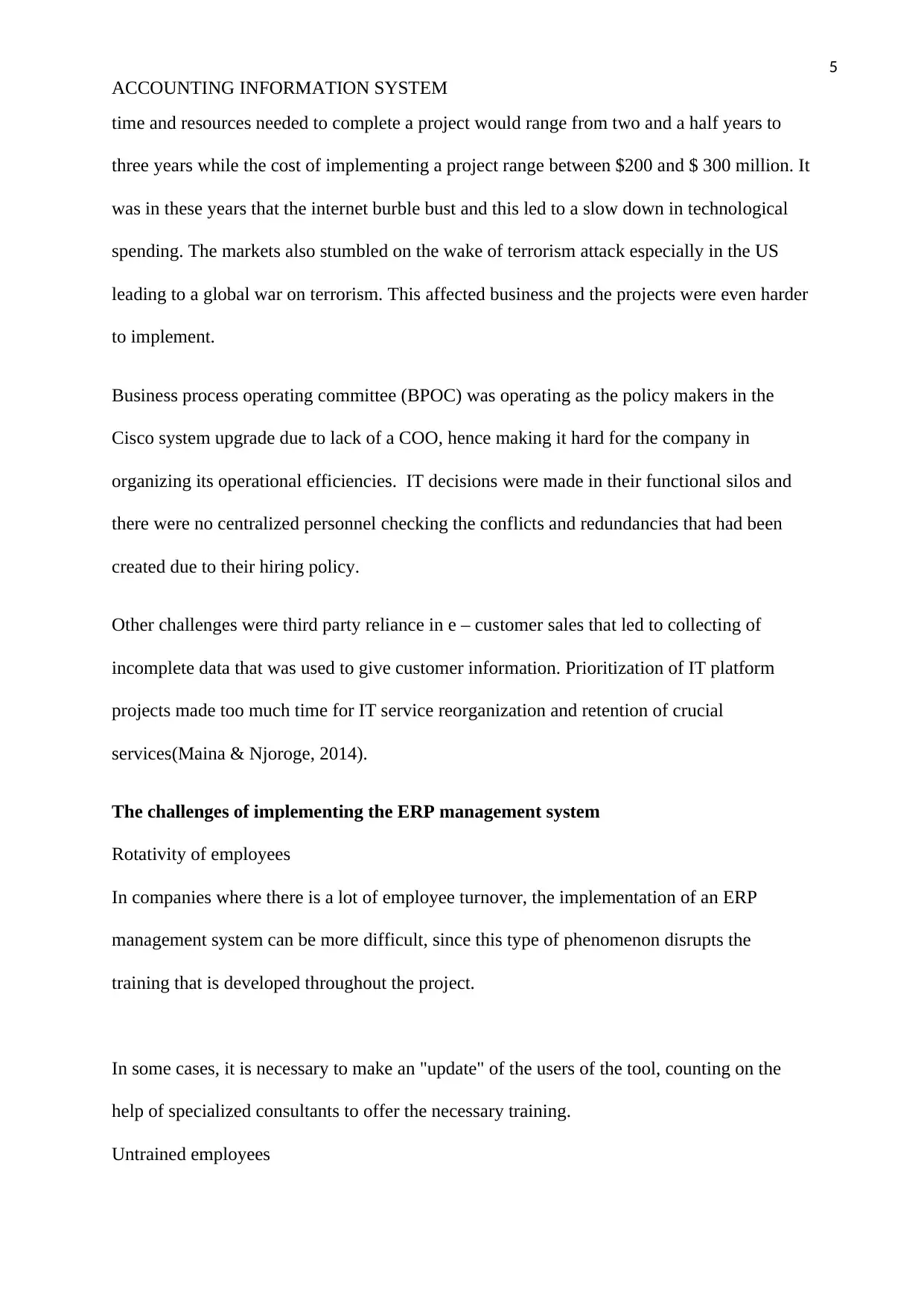
5
ACCOUNTING INFORMATION SYSTEM
time and resources needed to complete a project would range from two and a half years to
three years while the cost of implementing a project range between $200 and $ 300 million. It
was in these years that the internet burble bust and this led to a slow down in technological
spending. The markets also stumbled on the wake of terrorism attack especially in the US
leading to a global war on terrorism. This affected business and the projects were even harder
to implement.
Business process operating committee (BPOC) was operating as the policy makers in the
Cisco system upgrade due to lack of a COO, hence making it hard for the company in
organizing its operational efficiencies. IT decisions were made in their functional silos and
there were no centralized personnel checking the conflicts and redundancies that had been
created due to their hiring policy.
Other challenges were third party reliance in e – customer sales that led to collecting of
incomplete data that was used to give customer information. Prioritization of IT platform
projects made too much time for IT service reorganization and retention of crucial
services(Maina & Njoroge, 2014).
The challenges of implementing the ERP management system
Rotativity of employees
In companies where there is a lot of employee turnover, the implementation of an ERP
management system can be more difficult, since this type of phenomenon disrupts the
training that is developed throughout the project.
In some cases, it is necessary to make an "update" of the users of the tool, counting on the
help of specialized consultants to offer the necessary training.
Untrained employees
ACCOUNTING INFORMATION SYSTEM
time and resources needed to complete a project would range from two and a half years to
three years while the cost of implementing a project range between $200 and $ 300 million. It
was in these years that the internet burble bust and this led to a slow down in technological
spending. The markets also stumbled on the wake of terrorism attack especially in the US
leading to a global war on terrorism. This affected business and the projects were even harder
to implement.
Business process operating committee (BPOC) was operating as the policy makers in the
Cisco system upgrade due to lack of a COO, hence making it hard for the company in
organizing its operational efficiencies. IT decisions were made in their functional silos and
there were no centralized personnel checking the conflicts and redundancies that had been
created due to their hiring policy.
Other challenges were third party reliance in e – customer sales that led to collecting of
incomplete data that was used to give customer information. Prioritization of IT platform
projects made too much time for IT service reorganization and retention of crucial
services(Maina & Njoroge, 2014).
The challenges of implementing the ERP management system
Rotativity of employees
In companies where there is a lot of employee turnover, the implementation of an ERP
management system can be more difficult, since this type of phenomenon disrupts the
training that is developed throughout the project.
In some cases, it is necessary to make an "update" of the users of the tool, counting on the
help of specialized consultants to offer the necessary training.
Untrained employees
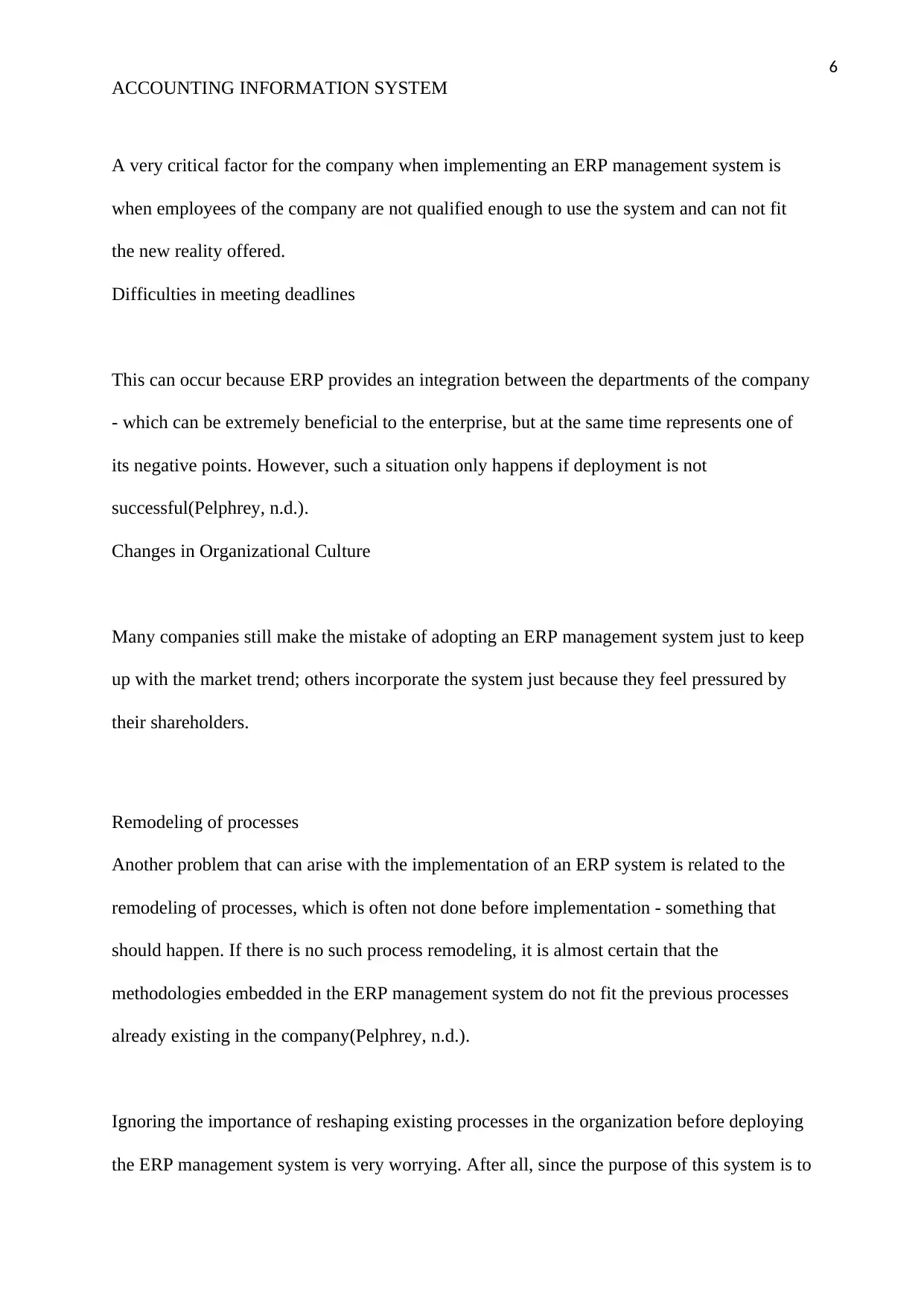
6
ACCOUNTING INFORMATION SYSTEM
A very critical factor for the company when implementing an ERP management system is
when employees of the company are not qualified enough to use the system and can not fit
the new reality offered.
Difficulties in meeting deadlines
This can occur because ERP provides an integration between the departments of the company
- which can be extremely beneficial to the enterprise, but at the same time represents one of
its negative points. However, such a situation only happens if deployment is not
successful(Pelphrey, n.d.).
Changes in Organizational Culture
Many companies still make the mistake of adopting an ERP management system just to keep
up with the market trend; others incorporate the system just because they feel pressured by
their shareholders.
Remodeling of processes
Another problem that can arise with the implementation of an ERP system is related to the
remodeling of processes, which is often not done before implementation - something that
should happen. If there is no such process remodeling, it is almost certain that the
methodologies embedded in the ERP management system do not fit the previous processes
already existing in the company(Pelphrey, n.d.).
Ignoring the importance of reshaping existing processes in the organization before deploying
the ERP management system is very worrying. After all, since the purpose of this system is to
ACCOUNTING INFORMATION SYSTEM
A very critical factor for the company when implementing an ERP management system is
when employees of the company are not qualified enough to use the system and can not fit
the new reality offered.
Difficulties in meeting deadlines
This can occur because ERP provides an integration between the departments of the company
- which can be extremely beneficial to the enterprise, but at the same time represents one of
its negative points. However, such a situation only happens if deployment is not
successful(Pelphrey, n.d.).
Changes in Organizational Culture
Many companies still make the mistake of adopting an ERP management system just to keep
up with the market trend; others incorporate the system just because they feel pressured by
their shareholders.
Remodeling of processes
Another problem that can arise with the implementation of an ERP system is related to the
remodeling of processes, which is often not done before implementation - something that
should happen. If there is no such process remodeling, it is almost certain that the
methodologies embedded in the ERP management system do not fit the previous processes
already existing in the company(Pelphrey, n.d.).
Ignoring the importance of reshaping existing processes in the organization before deploying
the ERP management system is very worrying. After all, since the purpose of this system is to
⊘ This is a preview!⊘
Do you want full access?
Subscribe today to unlock all pages.

Trusted by 1+ million students worldwide
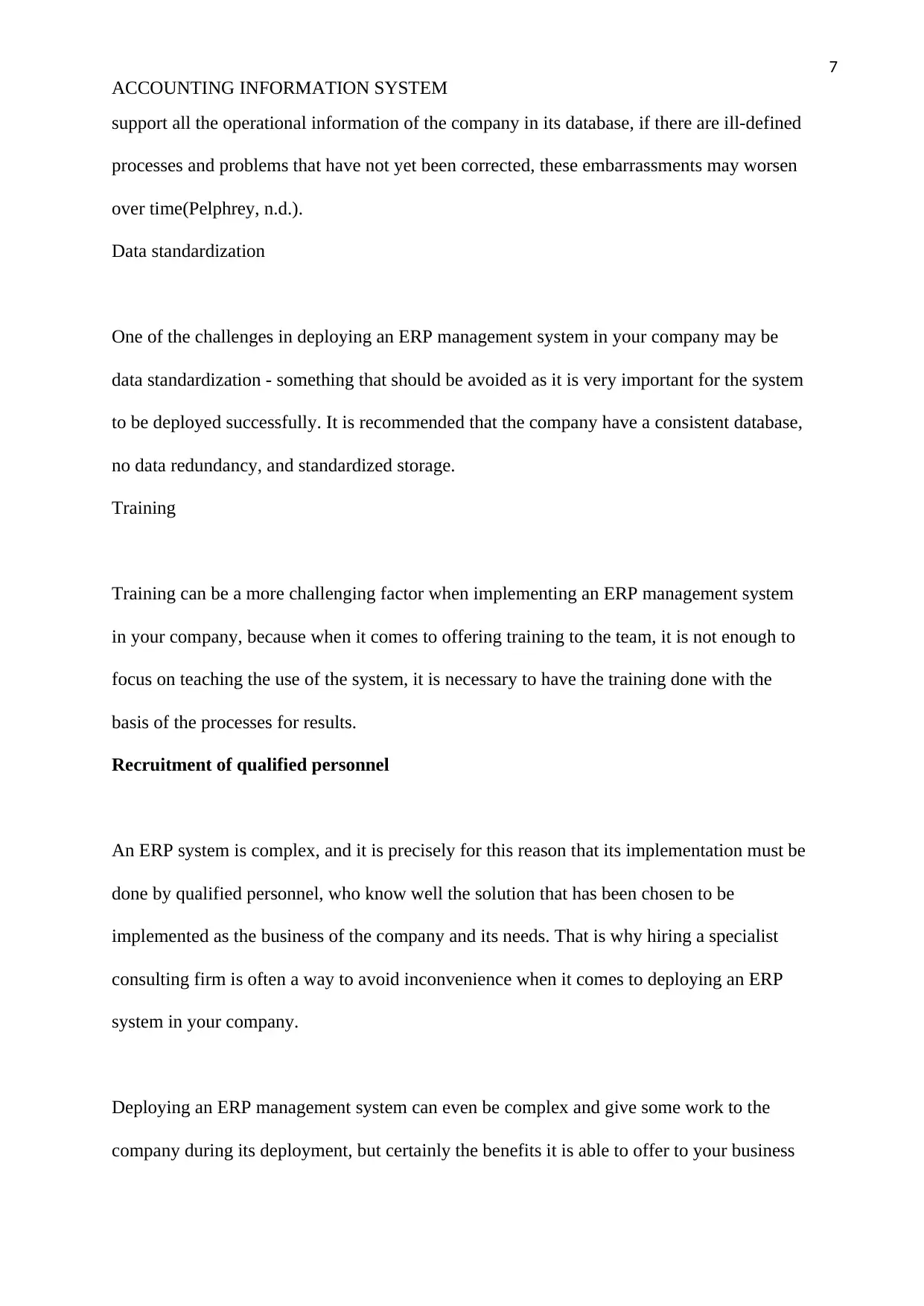
7
ACCOUNTING INFORMATION SYSTEM
support all the operational information of the company in its database, if there are ill-defined
processes and problems that have not yet been corrected, these embarrassments may worsen
over time(Pelphrey, n.d.).
Data standardization
One of the challenges in deploying an ERP management system in your company may be
data standardization - something that should be avoided as it is very important for the system
to be deployed successfully. It is recommended that the company have a consistent database,
no data redundancy, and standardized storage.
Training
Training can be a more challenging factor when implementing an ERP management system
in your company, because when it comes to offering training to the team, it is not enough to
focus on teaching the use of the system, it is necessary to have the training done with the
basis of the processes for results.
Recruitment of qualified personnel
An ERP system is complex, and it is precisely for this reason that its implementation must be
done by qualified personnel, who know well the solution that has been chosen to be
implemented as the business of the company and its needs. That is why hiring a specialist
consulting firm is often a way to avoid inconvenience when it comes to deploying an ERP
system in your company.
Deploying an ERP management system can even be complex and give some work to the
company during its deployment, but certainly the benefits it is able to offer to your business
ACCOUNTING INFORMATION SYSTEM
support all the operational information of the company in its database, if there are ill-defined
processes and problems that have not yet been corrected, these embarrassments may worsen
over time(Pelphrey, n.d.).
Data standardization
One of the challenges in deploying an ERP management system in your company may be
data standardization - something that should be avoided as it is very important for the system
to be deployed successfully. It is recommended that the company have a consistent database,
no data redundancy, and standardized storage.
Training
Training can be a more challenging factor when implementing an ERP management system
in your company, because when it comes to offering training to the team, it is not enough to
focus on teaching the use of the system, it is necessary to have the training done with the
basis of the processes for results.
Recruitment of qualified personnel
An ERP system is complex, and it is precisely for this reason that its implementation must be
done by qualified personnel, who know well the solution that has been chosen to be
implemented as the business of the company and its needs. That is why hiring a specialist
consulting firm is often a way to avoid inconvenience when it comes to deploying an ERP
system in your company.
Deploying an ERP management system can even be complex and give some work to the
company during its deployment, but certainly the benefits it is able to offer to your business
Paraphrase This Document
Need a fresh take? Get an instant paraphrase of this document with our AI Paraphraser
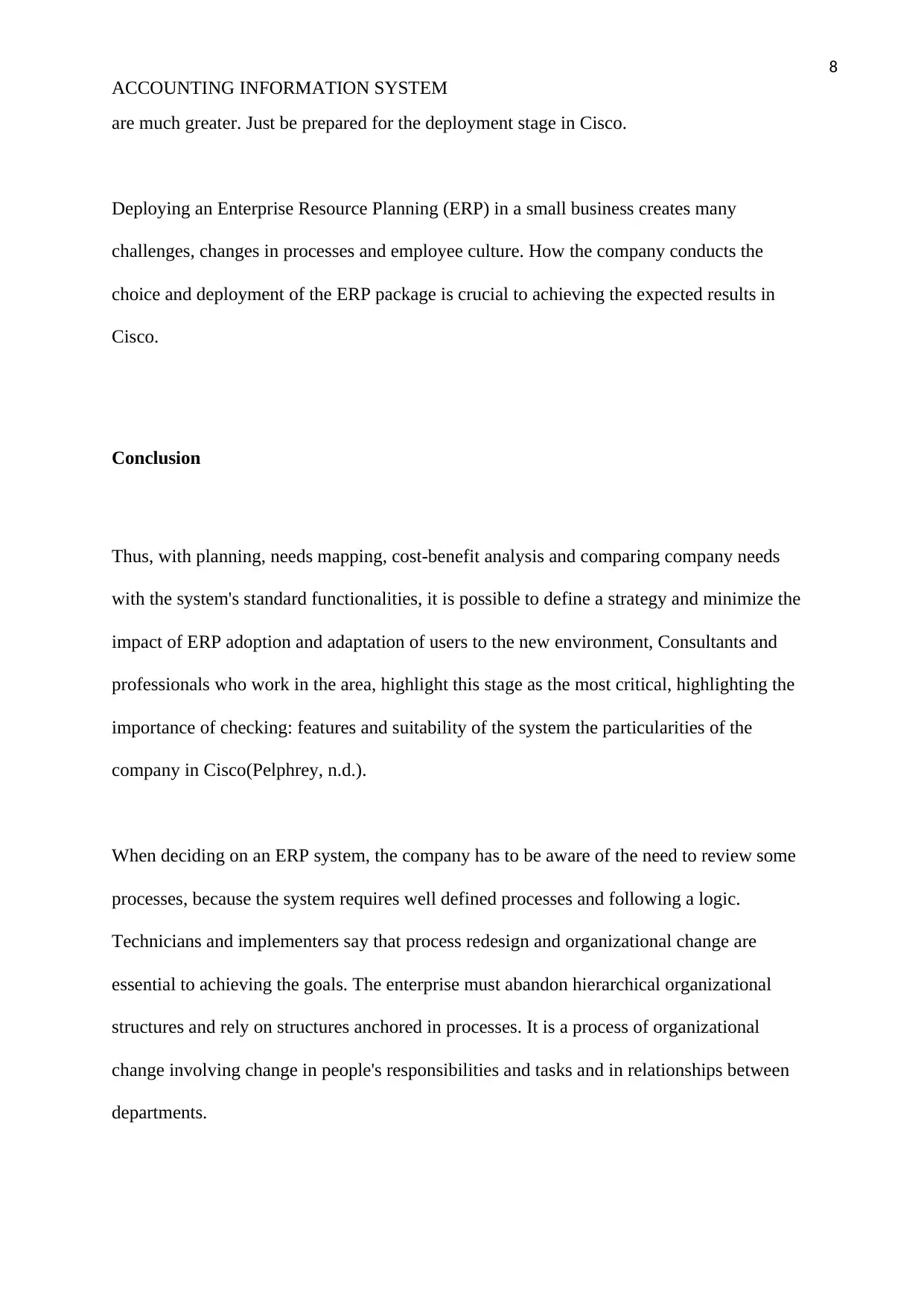
8
ACCOUNTING INFORMATION SYSTEM
are much greater. Just be prepared for the deployment stage in Cisco.
Deploying an Enterprise Resource Planning (ERP) in a small business creates many
challenges, changes in processes and employee culture. How the company conducts the
choice and deployment of the ERP package is crucial to achieving the expected results in
Cisco.
Conclusion
Thus, with planning, needs mapping, cost-benefit analysis and comparing company needs
with the system's standard functionalities, it is possible to define a strategy and minimize the
impact of ERP adoption and adaptation of users to the new environment, Consultants and
professionals who work in the area, highlight this stage as the most critical, highlighting the
importance of checking: features and suitability of the system the particularities of the
company in Cisco(Pelphrey, n.d.).
When deciding on an ERP system, the company has to be aware of the need to review some
processes, because the system requires well defined processes and following a logic.
Technicians and implementers say that process redesign and organizational change are
essential to achieving the goals. The enterprise must abandon hierarchical organizational
structures and rely on structures anchored in processes. It is a process of organizational
change involving change in people's responsibilities and tasks and in relationships between
departments.
ACCOUNTING INFORMATION SYSTEM
are much greater. Just be prepared for the deployment stage in Cisco.
Deploying an Enterprise Resource Planning (ERP) in a small business creates many
challenges, changes in processes and employee culture. How the company conducts the
choice and deployment of the ERP package is crucial to achieving the expected results in
Cisco.
Conclusion
Thus, with planning, needs mapping, cost-benefit analysis and comparing company needs
with the system's standard functionalities, it is possible to define a strategy and minimize the
impact of ERP adoption and adaptation of users to the new environment, Consultants and
professionals who work in the area, highlight this stage as the most critical, highlighting the
importance of checking: features and suitability of the system the particularities of the
company in Cisco(Pelphrey, n.d.).
When deciding on an ERP system, the company has to be aware of the need to review some
processes, because the system requires well defined processes and following a logic.
Technicians and implementers say that process redesign and organizational change are
essential to achieving the goals. The enterprise must abandon hierarchical organizational
structures and rely on structures anchored in processes. It is a process of organizational
change involving change in people's responsibilities and tasks and in relationships between
departments.
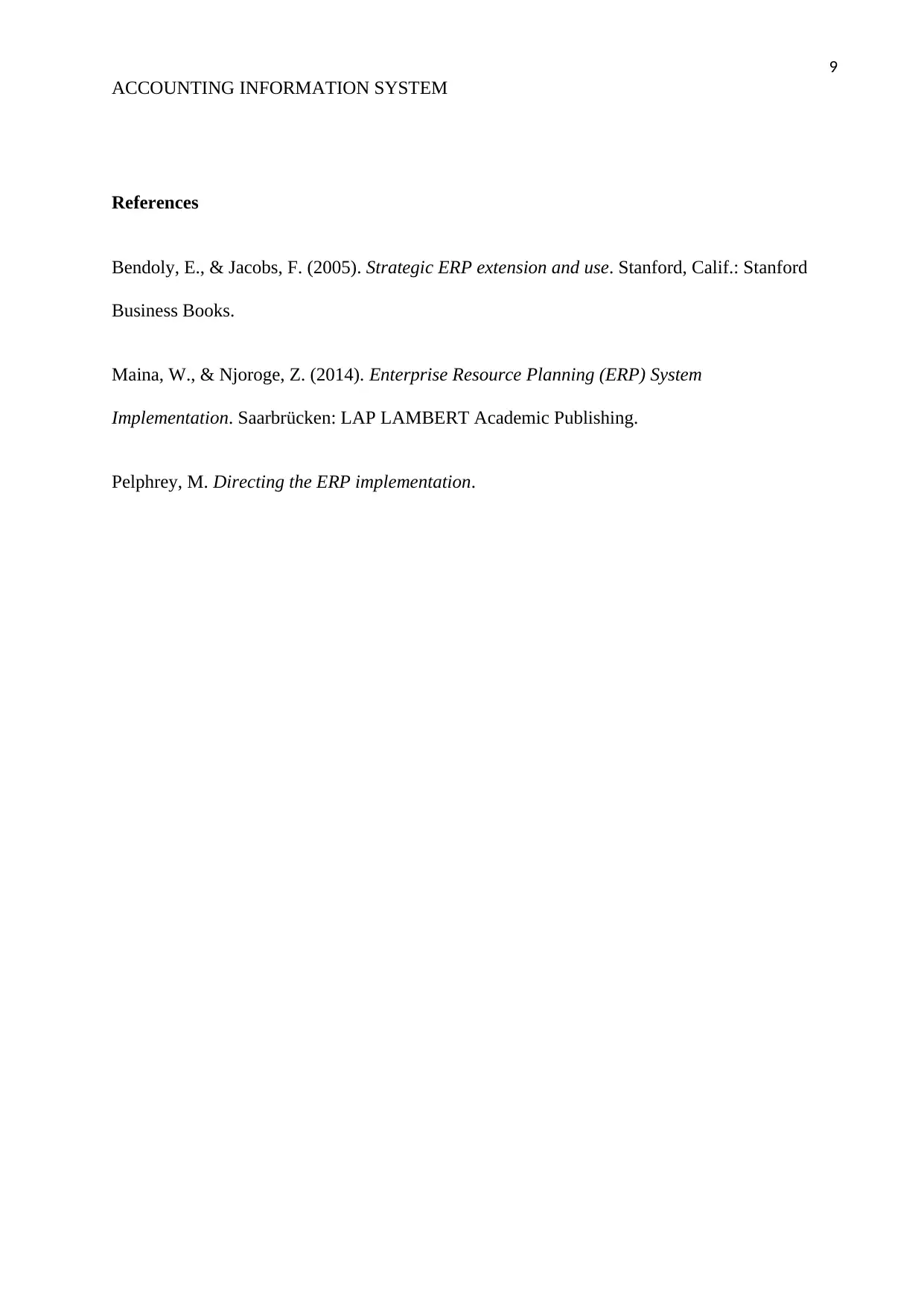
9
ACCOUNTING INFORMATION SYSTEM
References
Bendoly, E., & Jacobs, F. (2005). Strategic ERP extension and use. Stanford, Calif.: Stanford
Business Books.
Maina, W., & Njoroge, Z. (2014). Enterprise Resource Planning (ERP) System
Implementation. Saarbrücken: LAP LAMBERT Academic Publishing.
Pelphrey, M. Directing the ERP implementation.
ACCOUNTING INFORMATION SYSTEM
References
Bendoly, E., & Jacobs, F. (2005). Strategic ERP extension and use. Stanford, Calif.: Stanford
Business Books.
Maina, W., & Njoroge, Z. (2014). Enterprise Resource Planning (ERP) System
Implementation. Saarbrücken: LAP LAMBERT Academic Publishing.
Pelphrey, M. Directing the ERP implementation.
⊘ This is a preview!⊘
Do you want full access?
Subscribe today to unlock all pages.

Trusted by 1+ million students worldwide
1 out of 9
Your All-in-One AI-Powered Toolkit for Academic Success.
+13062052269
info@desklib.com
Available 24*7 on WhatsApp / Email
![[object Object]](/_next/static/media/star-bottom.7253800d.svg)
Unlock your academic potential
Copyright © 2020–2025 A2Z Services. All Rights Reserved. Developed and managed by ZUCOL.

